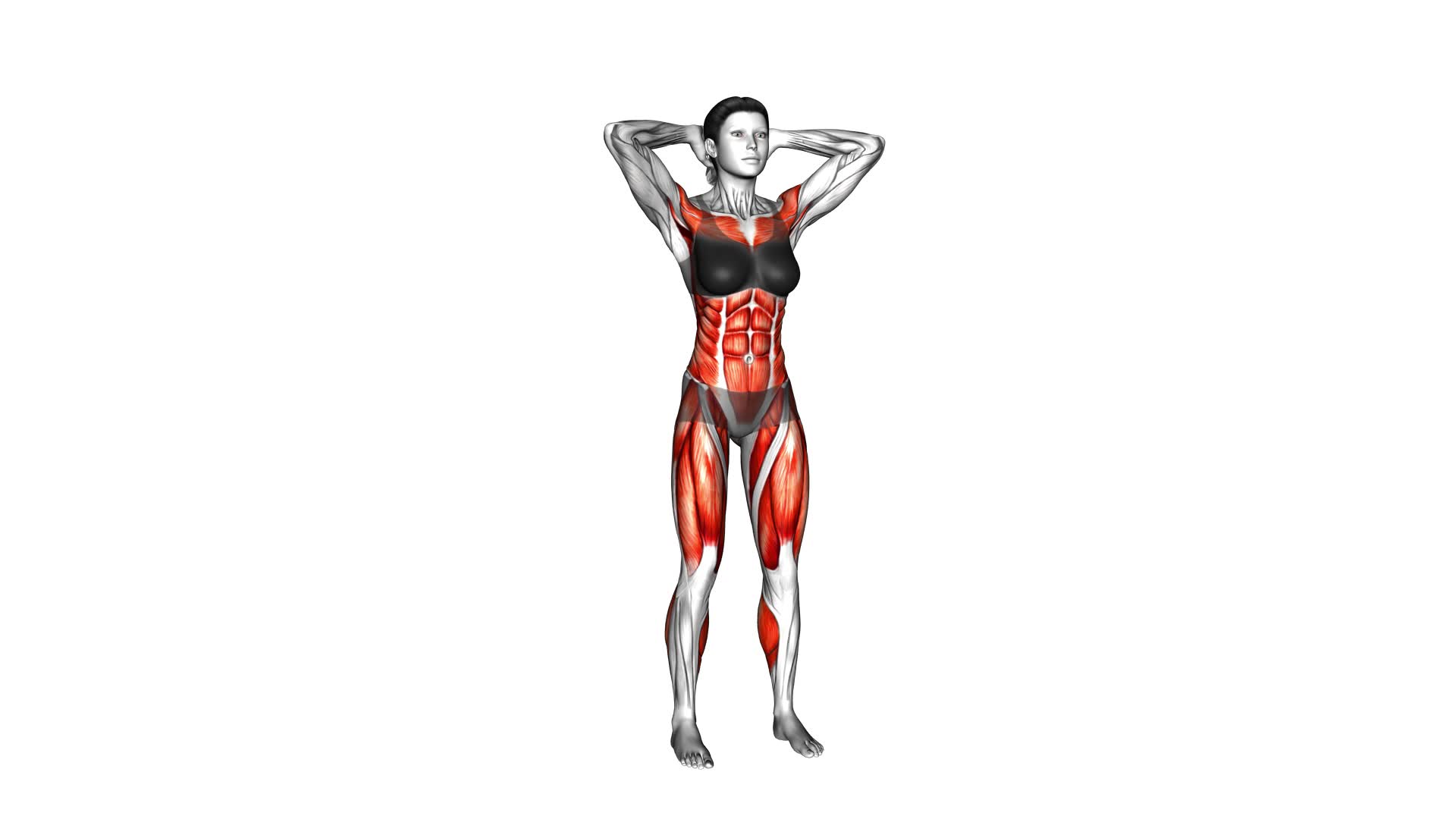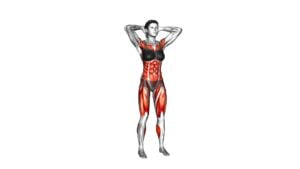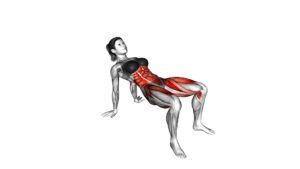Double Knee To Toe Touch (female) – Video Exercise Guide & Tips

Are you looking to tone your abs and improve your flexibility? The Double Knee to Toe Touch exercise is perfect for you!
Watch This Exercise Video
In this video exercise guide, we'll show you how to properly perform this move, along with helpful tips and modifications for beginners.
You'll also discover advanced variations to take your workout to the next level.
Get ready to maximize your results and achieve a stronger, more toned body.
Let's dive in!
Key Takeaways
- The double knee to toe touch exercise helps improve flexibility and core strength.
- Proper form and technique are important to avoid injury and maximize the benefits of the exercise.
- Beginners can modify the exercise by reducing the range of motion or using additional support.
- Advanced variations and progressions can be implemented to challenge and improve flexibility and strength.
Benefits of the Double Knee to Toe Touch
Improve your flexibility and core strength by incorporating the double knee to toe touch into your workout routine. This exercise offers a range of benefits, including injury prevention and flexibility improvement.
One of the key advantages of the double knee to toe touch is its ability to prevent injuries. By engaging your core muscles and increasing your flexibility, you can reduce the risk of strains and sprains during physical activities. This exercise targets the muscles in your lower back, hips, and hamstrings, which are commonly prone to injuries if not properly conditioned.
Additionally, the double knee to toe touch significantly enhances your flexibility. As you reach down to touch your toes, you're stretching and lengthening your muscles, increasing your overall range of motion. This improved flexibility can have a positive impact on your daily activities, as well as your performance in sports and exercise routines.
Incorporating the double knee to toe touch into your workout routine is a simple yet effective way to improve your flexibility and core strength. By regularly performing this exercise, you can reduce the risk of injuries and enhance your overall physical performance.
Proper Form and Technique
To perform the double knee to toe touch exercise with proper form and technique, follow these steps.
Begin by standing with your feet shoulder-width apart and your arms extended overhead. As you exhale, bend your knees and bring them up towards your chest while simultaneously reaching your hands towards your toes.
It's important to keep your core engaged and your back straight throughout the movement. Make sure to maintain control and avoid any jerky or uncontrolled movements.
When performing the double knee to toe touch exercise, there are a few common mistakes to avoid.
One common mistake is rounding the back as you bend your knees and reach for your toes. This can put unnecessary strain on your lower back and increase the risk of injury.
Another common mistake is using momentum to swing your legs up towards your chest. This can take away from the effectiveness of the exercise and also increase the risk of injury.
Speaking of injuries, it's important to be aware of the potential risks associated with the double knee to toe touch exercise.
The most common injuries include strains or sprains in the lower back, hamstrings, or hip flexors. These injuries can occur if the exercise is performed with poor form or if you push yourself too hard without proper warm-up or conditioning.
It's always important to listen to your body and modify or stop the exercise if you experience any pain or discomfort.
Modifications for Beginners
To make the double knee to toe touch exercise more accessible for beginners, modifications can be implemented to ensure proper form and technique. Here are some beginner modifications you can try:
- Reduce the range of motion: Instead of reaching for your toes, start by reaching for your knees or shins. This will allow you to gradually increase your flexibility and avoid straining your muscles.
- Use a stability ball: Place a stability ball between your lower back and a wall. As you perform the exercise, use the ball as a support to maintain balance and stability. This modification provides additional support and helps maintain proper form.
- Perform the exercise seated: If the standing position is too challenging, you can perform the double knee to toe touch exercise while sitting on a chair. This modification reduces the load on your core and allows you to focus on proper technique.
Advanced Variations and Progressions
To further challenge yourself and continue your progress, incorporate advanced variations and progressions into your double knee to toe touch exercise routine. These advanced modifications will take your workout to the next level and help you achieve even greater flexibility and strength.
One advanced variation you can try is the single leg double knee to toe touch. Instead of bending both knees, keep one leg straight while you bend the other knee and touch your toes. This variation targets your core and balance even more intensely.
Another advanced progression is to add ankle weights or resistance bands to your ankles. This will increase the resistance and make the exercise more challenging for your muscles.
As you incorporate these advanced modifications, be mindful of common mistakes. One common mistake is rounding your back instead of keeping it straight and neutral. Remember to engage your core and maintain proper posture throughout the exercise.
Another mistake is using momentum to swing your legs instead of using controlled movements. Focus on slow and controlled movements to maximize the effectiveness of the exercise.
Tips for Maximizing Results
To maximize your results and make the most out of your double knee to toe touch exercise routine, it's important to implement a few key tips and strategies. Here are three tips to help you maximize your results and avoid common mistakes and injuries:
- Warm up properly: Before starting any exercise routine, it's crucial to warm up your muscles to prevent injuries. Perform dynamic stretches and light cardio exercises to increase blood flow and prepare your body for the workout.
- Focus on form: Proper form is essential for maximizing the effectiveness of the double knee to toe touch exercise. Keep your back straight, engage your core, and avoid rounding your shoulders. This will target the correct muscles and prevent strain on your back and neck.
- Gradually increase intensity: Start with a comfortable range of motion and gradually increase the intensity as your flexibility and strength improve. Push yourself, but listen to your body and avoid overexertion. This will help prevent common injuries such as muscle strains or sprains.
Frequently Asked Questions
How Many Repetitions and Sets Should I Do for the Double Knee to Toe Touch Exercise?
To determine the number of repetitions and sets for the double knee to toe touch exercise, it's important to consider your fitness level and goals. Generally, it's recommended to start with 2-3 sets of 10-12 repetitions.
As you progress, you can increase the number of sets or repetitions to challenge yourself. For beginners, modifications like reducing the range of motion or using a stability ball can make the exercise more manageable.
Always listen to your body and adjust accordingly.
Can I Perform the Double Knee to Toe Touch Exercise if I Have a History of Knee Injuries?
If you have a history of knee injuries, it's important to take some precautions before performing the double knee to toe touch exercise.
Make sure to consult with a healthcare professional or a qualified trainer to ensure it's safe for you. They can guide you on modifications that can be made to the exercise to accommodate your knee injuries and reduce the risk of further damage.
Your safety should always be the top priority.
Is It Necessary to Warm up Before Doing the Double Knee to Toe Touch Exercise?
Before doing the double knee to toe touch exercise, it's necessary for you to warm up. Warming up helps to prepare your muscles and joints for the workout ahead. It increases blood flow, flexibility, and reduces the risk of injury.
Incorporating stretching techniques into your warm-up routine can further enhance your performance and prevent muscle strains. So, make sure to warm up properly before attempting the double knee to toe touch exercise.
How Should I Incorporate the Double Knee to Toe Touch Exercise Into My Existing Workout Routine?
To incorporate the double knee to toe touch exercise into your existing workout routine, start by understanding the modifications for beginners. This will help you gradually build strength and flexibility.
Once you're comfortable with the basic movement, you can increase the intensity by adding weights or performing more repetitions.
Incorporating this exercise into your routine offers several benefits, such as improving core strength, enhancing balance, and increasing lower body flexibility.
It's a great way to target multiple muscle groups and add variety to your workouts.
Are There Any Specific Breathing Techniques to Follow While Performing the Double Knee to Toe Touch Exercise?
When performing the double knee to toe touch exercise, it's important to focus on your breathing. Take a deep breath in as you lift your legs and reach for your toes, and exhale as you lower them back down. This will help you maintain proper control and stability throughout the movement.
For beginners, you can modify the exercise by bending your knees slightly and reaching towards your shins instead of your toes. Remember to listen to your body and adjust the intensity as needed.
Conclusion
In conclusion, the double knee to toe touch exercise is a beneficial way to improve flexibility, core strength, and overall fitness. By following proper form and technique, beginners can modify the exercise to suit their needs, while advanced individuals can challenge themselves with variations and progressions.
Remember to listen to your body, take breaks when needed, and gradually increase intensity for optimal results. Incorporating this exercise into your routine will help you achieve your fitness goals.

Author
Years ago, the spark of my life’s passion ignited in my mind the moment I stepped into the local gym for the first time. The inaugural bead of perspiration, the initial endeavor, the very first surge of endorphins, and a sense of pride that washed over me post-workout marked the beginning of my deep-seated interest in strength sports, fitness, and sports nutrition. This very curiosity blossomed rapidly into a profound fascination, propelling me to earn a Master’s degree in Physical Education from the Academy of Physical Education in Krakow, followed by a Sports Manager diploma from the Jagiellonian University. My journey of growth led me to gain more specialized qualifications, such as being a certified personal trainer with a focus on sports dietetics, a lifeguard, and an instructor for wellness and corrective gymnastics. Theoretical knowledge paired seamlessly with practical experience, reinforcing my belief that the transformation of individuals under my guidance was also a reflection of my personal growth. This belief holds true even today. Each day, I strive to push the boundaries and explore new realms. These realms gently elevate me to greater heights. The unique combination of passion for my field and the continuous quest for growth fuels my drive to break new ground.







